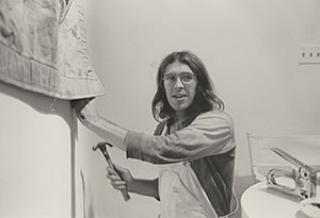Born 1944, Herington, Kansas
Died 2005, Shelter Island, New York
Drawing on skills first learned at home on his family’s farm, Alan Shields began to use sewing machines to create drawings in thread while studying civil engineering at Kansas State University. Inspired by the daily rhythms and know-how of his rural upbringing, he ignored the traditional gendered divisions between art and craft. In 1968 he left school for a gig at the legendary artist hangout in New York, Max’s Kansas City. The bar offered him a crash course in contemporary art, and he was soon represented by Paula Cooper Gallery. Shields quickly gained renown for his kaleidoscopic, free-hanging constructions, cobbled together from unconventional materials found on Canal Street. He cut a memorable figure himself, wearing fingernail polish, handmade clothing, and jewelry that matched his art.
The rigidity and rationality of the modernist grid is transformed in Shields’s work by a counterculture aesthetic of tie-dye and love beads and by techniques usually associated with feminine labor and the fiber arts. Using the stitched line as a means both to construct and to draw, Shields created multidimensional, double-sided works that resemble paintings expanded into real space. Inspired by the curvilinear interiors of Buckminster Fuller’s utopian architecture, his layered constructions can often be viewed from multiple perspectives. Shields applied rainbow hues of thinned acrylic paint to his eccentric forms and ornamented them with glass beads, wooden dowels, wire, gauze, and zigzag stitching. These intricate surfaces invite close examination even as they dissolve into clouds of lush color from afar.
Favoring industrial cotton belting for its sturdiness and flexibility, Shields merged the surface and support of painting, drawing it into new shapes and situations. The rectilinear structure of the grid, deformed by the laxity or tension of the belting, became a frequent subject. In Shape-Up, for instance, tiny garlands of beads cling to the soft, cotton trellis, twisting into three-dimensional tangles of color that echo the bright patches of paint staining the surface. A related piece, rendered in rosy, overheated colors, graced the cover of Artforum in 1971.
Jenevive Nykolak
Alan Shields: A Survey. Manhattan, KA: Beach Museum of Art, Kansas State University, 1999.
Wasserman, Emily. “Talking with Alan Shields.” Artforum 9, no. 6 (February 1971): 58–64.
